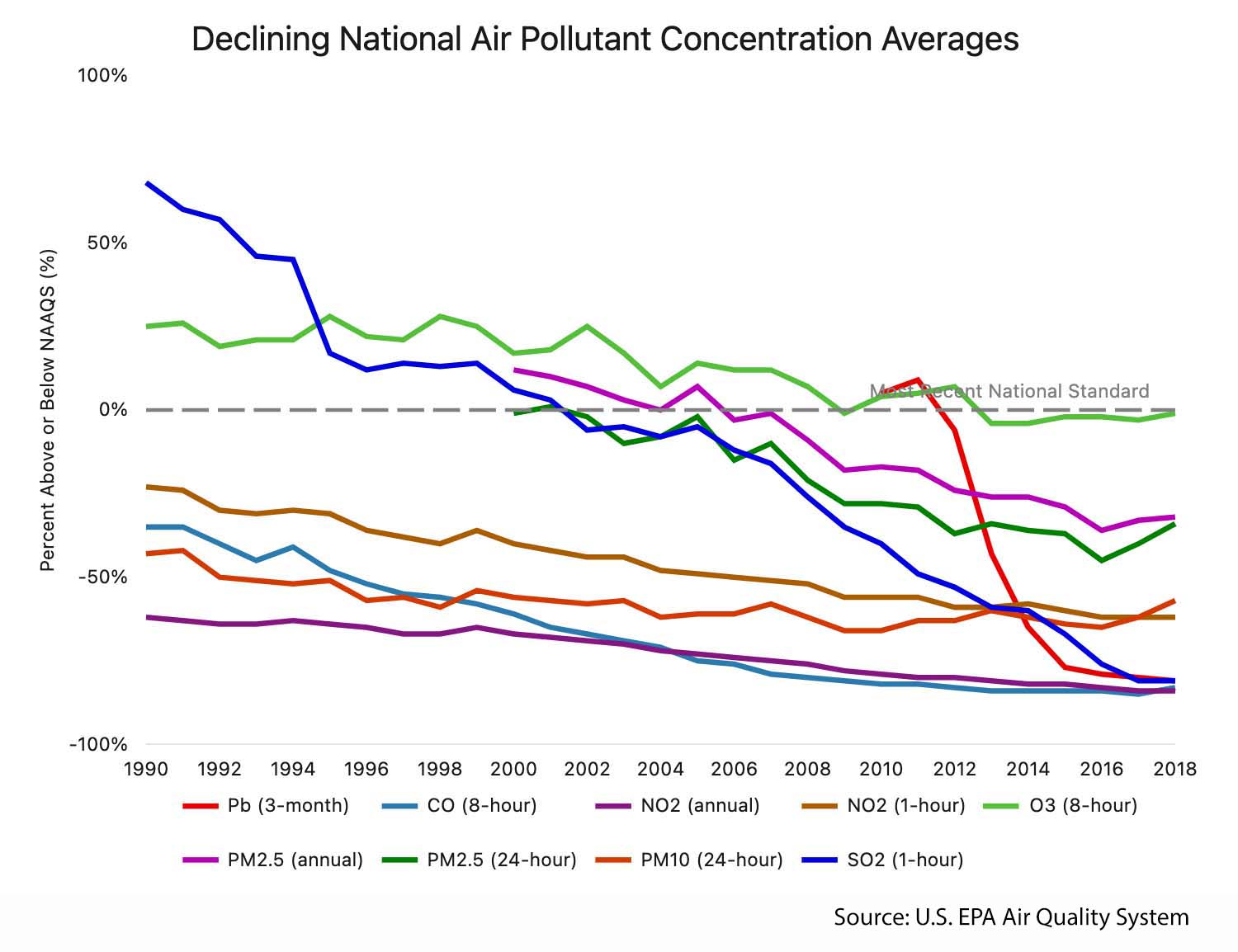There are certain sights that are specific to California: the Pacific Coast Highway overlooking the ocean, the Hollywood sign hovering above the hills, and thousands of smog check stations across the state. Since 1984, California drivers have been required to test the level of emissions coming from their vehicles. The car must be repaired or taken off the road if emissions are too high. The smog checks are just one of many initiatives that have helped to combat severe air pollution in California.
Air pollution, most famously the thick smog, has been a challenge in California since the 1940s due to geography, a dense population dependent on cars, and heavy industry.1 Although there is still a long way to go, the state has significantly reduced ozone and other pollutants. Improvement isn’t just limited to California; the entire United States has seen a reduction in human-caused air pollution in recent decades.2 This progress is thanks to interventions like the Clean Air Act, which celebrated its fiftieth anniversary this year.3

New Science on the Impact of Wildfires
Unfortunately, there is now evidence that the progress on air quality is being reversed by the pattern of severe wildfires that has emerged in the last ten years – with the most significant impact on the air out west.4 According to a study published last week, wildfires are taking a toll on the environment and the health of people living in the Western United States. To determine this, researchers analyzed levels of Particulate Matter 2.5 (PM2.5) and black carbon (BC) released in the atmosphere.
PM2.5 is one of the most common airborne pollutants and is in the atmosphere from both natural and artificial sources such as dirt or factory emissions.5 BC is a type of PM2.5, and it is one of the leading components of soot.6 Both are tiny particles that can embed deep into lung tissue, causing a variety of harm, from inflammation and decreased lung function, to congenital disabilities and premature death.
What Researchers Found
Research confirmed a decrease in the overall daily totals of PM2.5 and BC between 2000-2022 across the nation, with a reduction in premature deaths. But, since 2010, western states have seen an increase of PM2.5, BC, and there are an estimated 670 premature deaths each year. This is all linked to the severe wildfires of the past decade.
It was also suggested that the relative toxicity of these emissions is higher than in previous years, making the harm even greater. Although the worst outcomes for air quality are in the west, where wildfires predominantly burn, the entire country has seen an increase of consecutive days with PM2.5 levels that are above the level that is considered “safe.” (15 μg/m3)
The Overall Impact
In a press release, the lead corresponding author on the study Jun Wang, Ph.D. explained:
Our air is supposed to be cleaner and cleaner due mostly to EPA regulations on emissions, but the fires have limited or erased these air-quality gains [… ] In other words, all the efforts for the past 20 years by the EPA to make our air cleaner basically have been lost in fire-prone areas and downwind regions. We are losing ground.
More Research, More Concern
A different study, which had roughly the same conclusion, was published earlier this year in the scientific journal Nature.7 Scientists confirmed that levels of PM2.5 were once decreasing, but those improvements have either plateaued or reversed throughout the U.S. They used data from sources on the ground and from satellites to determine the impact of wildfire smoke on PM2.5 levels.
Since 2016, about 75% of the U.S. has seen an increase in the average annual PM2.5. According to the authors’ calculations, this is equivalent to the loss of 4 years of improvements in air quality overall, with an even more profound impact in western states.
Conclusion: Be Conscious of Air Quality
Scientists believe this trend in increased wildfire activity is linked to climate change. Experts anticipate that the length and severity of wildfires will continue to worsen in the years ahead. The authors of both studies conclude that the trend of increased air pollution is also likely to continue with the wildfires. This means air quality will continue to decline, with significant health impacts including inflammation, lung disease, and premature death.
As the wildfire season of 2023 demonstrated, the impact of wildfires can be far-reaching. When there is an increase in PM2.5 and other pollutants released into the atmosphere from wildfires, you may need to protect yourself and your family. This includes basic measures like limiting your physical activity outdoors or masking if you do need to go outside. Additionally, you may want to consider additional air filtration like an Austin Air Healthmate Plus, which can capture PM2.5 and smaller particles, as well as soot, gases, and other toxins from wildfires, which can enter the indoors from windows, doors, and HVAC systems.
REFERENCES
1 California Air Resources Board History (n.d.). California Air Resources Board. https://ww2.arb.ca.gov/about/history.
2 Our Nation’s Air. (2019). U.S. Environmental Protection Agency. https://gispub.epa.gov/air/trendsreport/2019/#highlights.
3 Aldy Joseph E, Auffhammer M, Cropper M, et al. 2022. Looking Back at 50 Years of the Clean Air Act. Journal of Economic Literature, 60 (1): 179-232. DOI: 10.1257/jel.20201626.
4 Wei J, Wang J, Li Z, et al. (2023, December). Long-term mortality burden trends attributed to black carbon and PM2·5 from wildfire emissions across the continental USA from 2000 to 2020: a deep learning modelling study. The Lancet Planetary Health, 7(12), e963–e975. DOI: 10.1016/s2542-5196(23)00235-8.
5 Particle Pollution. (2023, Feb 16.) Centers for Disease Control. https://www.cdc.gov/air/particulate_matter.html.
6 Curry Brown, A. (2013, December). Health Effects of Particulates and Black Carbon. Retrieved December 13, 2023, from https://www.epa.gov/sites/default/files/2014-05/documents/health-effects.pdf
7 Burke, M., Childs, M.L., de la Cuesta, B. et al. The contribution of wildfire to PM2.5 trends in the USA. Nature 622, 761–766 (2023). DOI: 10.1038/s41586-023-06522-6
